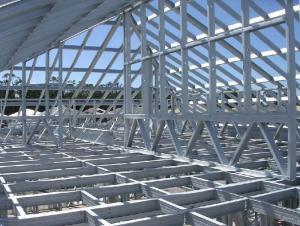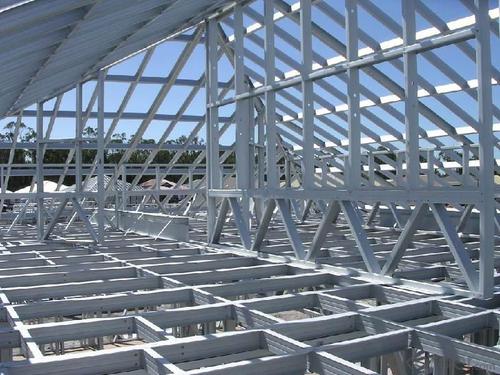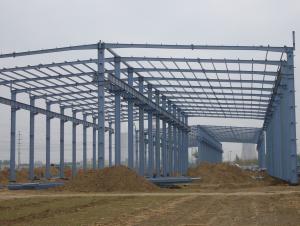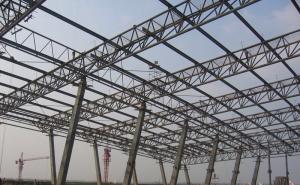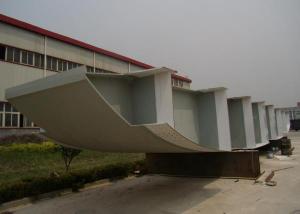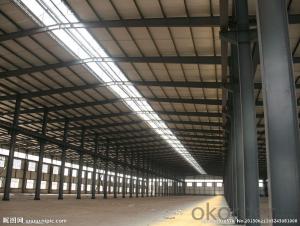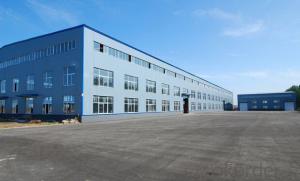Grid frame steel structure
- Loading Port:
- China Main Port
- Payment Terms:
- TT or LC
- Min Order Qty:
- -
- Supply Capability:
- -
OKorder Service Pledge
OKorder Financial Service
You Might Also Like
Product Description:
OKorder is offering steel structure at great prices with worldwide shipping. Our supplier is a world-class manufacturer of steel, with our products utilized the world over. OKorder annually supplies products to European, North American and Asian markets. We provide quotations within 24 hours of receiving an inquiry and guarantee competitive prices.
Product Applications:
1. Heavy industrial plants: relatively large span and column spacing; with a heavy duty crane or large-tonnage cranes; or plants with 2 to 3 layers cranes; as well as some high-temperature workshop should adopt steel crane beams, steel components, steel roof, steel columns, etc. up to the whole structure
2. Large span structure: the greater the span of the structure, the more significant economic benefits will have by reducing the weight of the structure
3. Towering structures and high-rise buildings: the towering structure, including high-voltage transmission line towers, substation structure, radio and television emission towers and masts, etc. These structures are mainly exposed to the wind load. Besides of its light weight and easy installation, structure steel can bring upon with more economic returns by reducing the wind load through its high-strength and smaller member section.
4. Structure under dynamic loads: As steel with good dynamic performance and toughness, so it can be used directly to crane beam bearing a greater or larger span bridge crane
5. Removable and mobile structures: Structure Steel can also apply to movable Exhibition hall and prefabricated house etc by virtue of its light weight, bolt connection, easy installation and uninstallation. In case of construction machinery, it is a must to use structure steel so as to reduce the structural weight.
6. Containers and pipes: the high-pressure pipe and pipeline, gas tank and boiler are all made of steel for the sake of its high strength and leakproofness
7. Light steel structure: light steel structures and portal frame structure combined with single angle or thin-walled structural steel with the advantages of light weight, build fast and steel saving etc., in recent years has been widely used.
8. Other buildings: Transport Corridor, trestle and various pipeline support frame, as well as blast furnaces and boilers frameworks are usually made of steel structure.
All in all, according to the reality, structure steel is widely used for high, large, heavy and light construction.
Product Advantages:
OKorder's steel structure are durable, strong, and resist corrosion.
Main Product Features:
· Premium quality
· Prompt delivery & seaworthy packing (30 days after receiving deposit)
· Corrosion resistance
· Can be recycled and reused
· Mill test certification
· Professional Service
· Competitive pricing
Product Specifications:
Specifications of steel structure
Project: Jinan west railway station
Position: The Beijing-Shanghai high speed railway (Jinan)
Steel dosage: 5000MTs
Structure type: Box, tube, bending and twisting, transverse connection
1. GB standard material
2. High Structural safety and reliability
3. The production can reach GB/JIS/ISO/ASME standard
Packaging & Delivery of steel structure
1. According to the project design and the component size, usually the main component parts are nude packing and shipped by bulk vessel. And the small parts are packed in box or suitable packages and shipped by containers.
2. This will be communicated and negotiated with buyer according to the design.
Engineering Design Software of steel structure
Tekla Structure \ AUTO CAD \ PKPM software etc
⊙Complex spatial structure project detailed design
⊙Construct 3D-model and structure analysis. ensure the accuracy of the workshop drawings
⊙Steel structure detail ,project management, automatic Shop Drawing, BOM table automatic generation system.
⊙Control the whole structure design process, we can obtain higher efficiency and better results
Technical support of steel structure
Worker | Rate of frontline workers with certificate on duty reaches 100% |
Welder | 186 welders got AWS & ASME qualification 124 welders got JIS qualification 56 welders got DNV &BV qualification |
Technical inspector | 40 inspectors with UT 2 certificate 10 inspectors with RT 2 certificate 12 inspectors with MT 2 certificate 3 inspectors with UT3 certificate |
Engineer | 21 engineers with senior title 49 engineers with medium title 70 engineers with primary title. 61 First-Class Construction Engineers 182 Second-Class Construction Engineers |
International certification | 10 engineers with International Welding engineer, 8 engineers with CWI. |
Production Flow of steel structure/steel frame
Material preparation—cutting—fitting up—welding—component correction—rust removal—paint coating—packing—to storage and transportation (each process has the relevant inspection)
Characters of Structure Steel
1. Steel is characterized by high strength, light weight, good rigidity, strong deformation capacity, so it is suitable for construction of large-span, super high and super-heavy buildings particularly;
2. It with good homogeneous and isotropic, is an ideal elastomer which perfectly fits the application of general engineering;
3. The material has good ductility and toughness, so it can have large deformation and it can well withstand dynamic loads;
4. Steel structure’s construction period is short;
5. Steel structure has high degree of industrialization and can realize-specialized production with high level of mechanization.
FAQ:
Q1: Why buy Materials & Equipment from OKorder.com?
A1: All products offered byOKorder.com are carefully selected from China's most reliable manufacturing enterprises. Through its ISO certifications, OKorder.com adheres to the highest standards and a commitment to supply chain safety and customer satisfaction.
Q2: How do we guarantee the quality of our products?
A2: We have established an advanced quality management system which conducts strict quality tests at every step, from raw materials to the final product. At the same time, we provide extensive follow-up service assurances as required.
Q3: How soon can we receive the product after purchase?
A3: Within three days of placing an order, we will begin production. The specific shipping date is dependent upon international and government factors, but is typically 7 to 10 workdays.
Images:
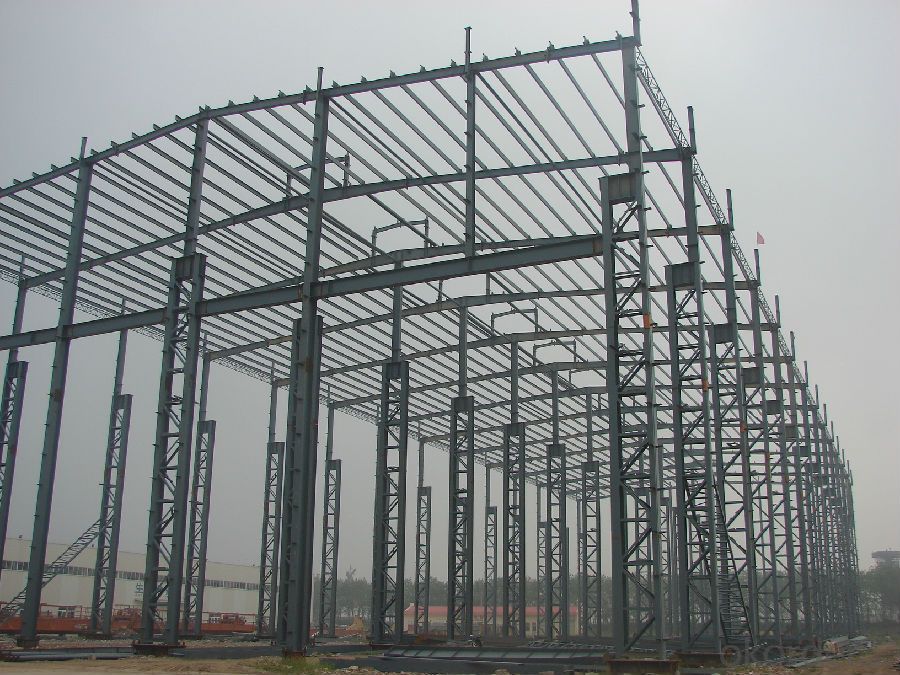
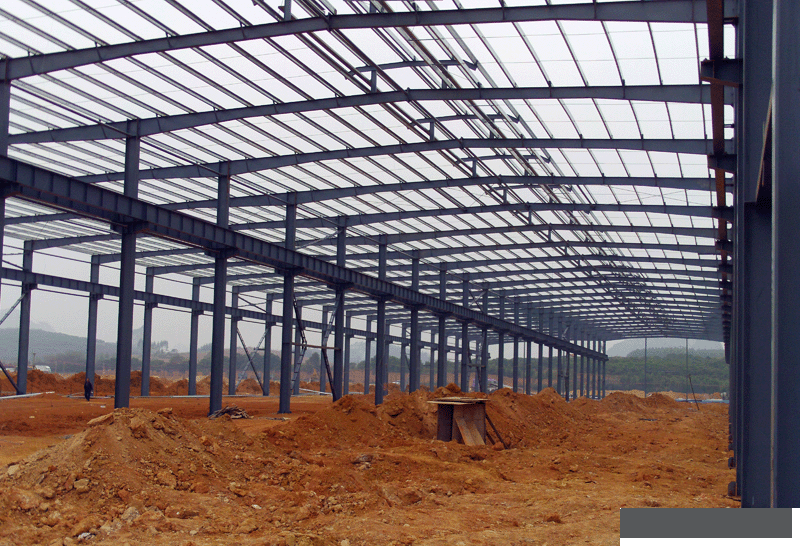
- Q: What are the considerations for steel structure design in high-wind areas?
- When designing steel structures in high-wind areas, several considerations need to be taken into account. Firstly, the structural members must be designed to withstand the increased wind loads by using appropriate design codes and standards. The shape and orientation of the structure should be optimized to minimize wind resistance and reduce the chances of wind-induced vibrations. Additionally, the connections between the structural elements should be designed to provide sufficient stiffness and strength to resist wind forces. Adequate bracing and cross-bracing should be incorporated to enhance the overall stability of the structure. Lastly, regular inspections and maintenance should be conducted to ensure the integrity and safety of the steel structure in high-wind areas.
- Q: What are the different types of steel fences and barriers used in buildings?
- There are several types of steel fences and barriers commonly used in buildings, including chain-link fences, ornamental steel fences, steel picket fences, and steel security barriers.
- Q: What are the considerations for aesthetic design in steel structures?
- Considerations for aesthetic design in steel structures include the choice of materials, the integration of architectural features, the use of color and finishes, as well as the overall visual appeal and coherence with the surrounding environment. Additionally, factors such as the building's purpose, site conditions, and budget constraints may also influence the aesthetic design choices.
- Q: How are steel structures used in the construction of research facilities?
- Steel structures are commonly used in the construction of research facilities due to their strength, durability, and flexibility. They provide the necessary support and stability for various complex components and equipment in research facilities, such as laboratories, cleanrooms, and testing areas. Steel structures also allow for large open spaces and can be easily modified or expanded as research needs evolve. Overall, steel structures play a crucial role in ensuring the safety, efficiency, and functionality of research facilities.
- Q: How is steel fabricated and shaped into structural components?
- Steel is fabricated and shaped into structural components through a series of processes. Initially, the steel is heated to a high temperature, making it malleable. It is then manipulated, using techniques such as rolling, forging, or extrusion, to give it the desired shape. Additional steps like cutting, drilling, and welding may be employed to refine the component further. Finally, the finished steel components are carefully inspected and tested to ensure they meet the necessary specifications and standards before being incorporated into structures.
- Q: What are the cost considerations of using steel in structures?
- The cost considerations of using steel in structures include the initial material cost, fabrication and installation expenses, and ongoing maintenance and repair costs. Steel is generally more expensive than other construction materials, such as wood or concrete, but it offers benefits such as strength, durability, and flexibility in design. Additionally, the cost of steel can fluctuate due to market conditions, making project budgeting challenging. However, steel structures often have a longer lifespan and require less maintenance, potentially offsetting the initial investment over time.
- Q: How are steel structures used in cultural and religious buildings?
- Steel structures are widely used in cultural and religious buildings for several reasons. Firstly, steel offers superior strength and durability, which is crucial for constructing large and complex structures that often serve as iconic symbols of cultural identity or religious significance. In cultural buildings like museums or art galleries, steel structures allow for large open spaces and flexible layouts, enabling the display of various exhibits and artwork. The use of steel beams and columns provides the necessary support to create vast open areas without the need for excessive columns or walls, allowing for a more visually appealing and immersive experience for visitors. Religious buildings, such as churches, cathedrals, or temples, often require soaring heights and intricate designs to evoke a sense of spirituality and grandeur. Steel structures allow architects and engineers to achieve these architectural feats by providing the necessary strength and stability. The use of steel also facilitates the incorporation of large stained glass windows, intricate ornamentation, and decorative elements, which are often crucial in religious buildings. Moreover, steel structures offer flexibility in terms of design and construction. They can be easily prefabricated off-site, ensuring precision and reducing construction time. This versatility allows for the creation of unique and innovative designs that reflect the cultural or religious values of the community. Additionally, steel structures are known for their sustainability. Steel is a recyclable material, and its use in construction reduces the need for other materials such as concrete or wood, which have a higher environmental impact. This aspect aligns well with the values of many cultural and religious organizations that prioritize environmental stewardship and sustainability. In conclusion, steel structures play a pivotal role in cultural and religious buildings by providing the necessary strength, flexibility, and sustainability. They enable the creation of awe-inspiring designs, large open spaces, and intricate details that reflect the cultural or religious identity of the community. Whether it is a museum, a church, or a temple, steel structures contribute to the construction of spaces that evoke a sense of wonder, spirituality, and cultural heritage.
- Q: How are steel structures designed for religious buildings such as churches and mosques?
- Steel structures for religious buildings such as churches and mosques are typically designed with a combination of architectural, engineering, and religious considerations in mind. The design process involves collaboration between architects, engineers, and religious leaders to create a space that is functional, aesthetically pleasing, and reflective of the religious beliefs and cultural values associated with the building. Steel's versatility, strength, and ability to span large distances make it an ideal material for creating unique and intricate designs, allowing for the creation of soaring ceilings, large open spaces, and intricate detailing. The design process also takes into account factors such as the building's location, seismic and weather conditions, and the specific needs of the religious community it will serve. Ultimately, steel structures for religious buildings are designed to provide a safe, durable, and inspiring space for worship and community gathering.
- Q: What are the design considerations for steel renewable energy projects?
- When designing steel renewable energy projects, there are several important considerations that need to be taken into account. Firstly, the structural design of the project is crucial. Steel offers excellent strength and durability, making it an ideal material for renewable energy projects. The design must ensure that the steel structures can withstand the environmental conditions, such as strong winds, earthquakes, and extreme temperatures, that they may be exposed to. Additionally, the design should incorporate factors such as load-bearing capacity, stability, and structural integrity to ensure the safety and reliability of the project. Secondly, the design should also consider the environmental impact of the steel renewable energy project. This includes factors such as the energy required for steel production, transportation, and installation. Choosing sustainable and low-carbon steel production methods, as well as optimizing the project's design to minimize the use of steel, can help reduce the carbon footprint of the project. Another important consideration is the maintenance and lifecycle costs of the project. Steel structures require regular inspections, maintenance, and repairs to ensure their longevity and performance. The design should take into account accessibility for maintenance, as well as the ease of replacing or repairing any steel components. This will help minimize downtime and maximize the project's operational efficiency. Furthermore, the design should also consider the integration of steel structures with other components of the renewable energy project. This includes connections to the renewable energy source, such as wind turbines or solar panels, as well as the electrical and mechanical systems. Ensuring proper alignment, compatibility, and efficient energy transfer between these components will optimize the overall performance of the project. Lastly, the design should also consider the aesthetic aspects of the project. Steel structures can be visually appealing and can contribute to the overall design and appearance of the renewable energy project. Incorporating architectural elements, such as innovative designs or artistic features, can enhance the visual appeal and public acceptance of the project. In conclusion, the design considerations for steel renewable energy projects involve structural integrity, environmental impact, maintenance and lifecycle costs, integration with other project components, and aesthetic appeal. By addressing these considerations, designers can create efficient, sustainable, and visually appealing steel renewable energy projects.
- Q: What is the role of steel in cultural and recreational buildings?
- Steel plays a crucial role in cultural and recreational buildings by providing strength, durability, and flexibility in their construction. Due to its high strength-to-weight ratio, steel allows for the creation of large, open spaces with minimal structural support, enabling the design of iconic and visually striking structures. Additionally, steel's resistance to corrosion and fire makes it a reliable choice for ensuring the safety and longevity of these buildings. Its versatility allows architects and designers to push the boundaries of creativity, resulting in unique and innovative cultural and recreational spaces.
Send your message to us
Grid frame steel structure
- Loading Port:
- China Main Port
- Payment Terms:
- TT or LC
- Min Order Qty:
- -
- Supply Capability:
- -
OKorder Service Pledge
OKorder Financial Service
Similar products
Hot products
Hot Searches
Related keywords
